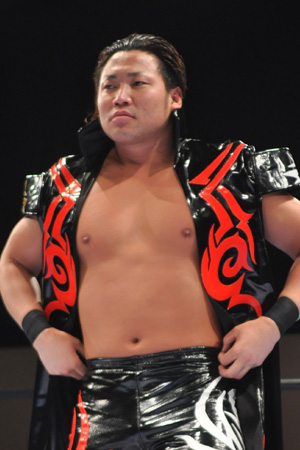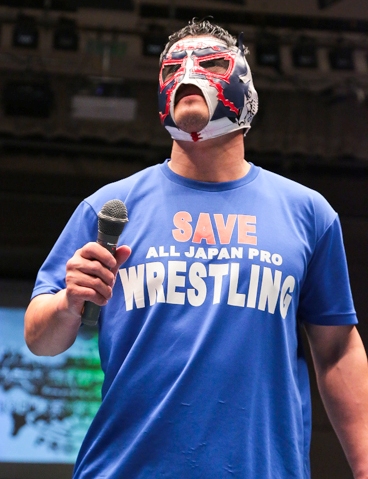All Japan Pro Wrestling will be having their 35th Champion Carnival tournament starting on April 13th and running to April 27th. The Carnival started in 1973 (it was not held from 83 – 90) as a single elimination tournament, but is now a round-robin tournament. A victory is worth two points, a time limit draw worth one, and a loss, double countout, or double disqualification worth zero. The winner of the Carnival gets a shot at AJPW’s Triple Crown Heavyweight Championship (unless he is already the current champ). There have been 6 men who went into the Carnival as the Triple Crown champion and won; those being Jumbo Tsuruta (91), Stan Hansen (92), Mitsuhara Misawa (98), Kenta Kobashi (2000), and Genichiro Tenryu (2001). One of the storylines heading into this year’s Carnival is that the current Triple Crown champ, Akebono, has vowed to be undefeated and be the first in 13 years to win the Carnival as champion.
The Champion Carnival for a long time (especially during the 1990’s) had a reputation for providing some of the best wrestling of the year and was a highlight of AJPW’s schedule. Unfortunately, neither the Carnival nor AJPW are what they used to be. AJPW was originally devastated when they lost essentially their entire roster in 2001 in the split with Misawa and Co. that lead to the creation of Pro Wrestling NOAH. Pretty much everyone expected AJPW to go out of business but instead they signed some key talent including Keiji “Great” Mutoh and Satoshi Kojima from NJPW and Genichiro Tenryu. Mutoh bought the company from the Baba family in 2002 and began the long and quite often painful rebuilding process.
There were a lot of missteps and business wasn’t great but by 2012 AJPW had developed a good roster of young talent and was putting on a fairly consistent & quality show. A number of old AJPW hands were beginning to defect back from NOAH, including top star Jun Akiyama. But then in February 2013 it was made public that Mutoh had sold his shares in AJPW to businessman Nobuo Shiraishi. Shiraishi apparently made himself rather unpopular with many of the wrestlers quite quickly and has been seen by many as a money mark. At the start of June 2013, Mutoh left AJPW and was followed in the coming weeks by more than a dozen of AJPW’s roster including top stars such as Masakatsu Funaki. Mutoh started up the rival WRESTLE-1.
With its roster once more depleted and business in a slump things are far from good for AJPW. They’ve made up for their losses by bringing in freelancers and independent talent from the DDT promotion to provide warm bodies which have led to some interesting shows but there aren’t that many big heavyweight names out there and that’s what the Carnival is about. All of that means this this year’s Carnival has what looks like on paper one of the least inspiring rosters in memory. That said, AJPW has surprised us before so you never know. I decided to put together a guide to the Carnival participants similar to the one I did for last year’s G1 Climax.
A Block
Akebono
The Current AJPW Triple Crown Heavyweight Champion, was born Chad Rowan in the US but is best known to Japanese (and worldwide) as Akebono due to his huge success in the world of Sumo. Akebono was, at 6 foot 8 and 514 pounds, one of the biggest Sumos in history and also the first non-Japanese to reach the rank of Yokozuna, which is the highest rank in the sport, an honor he attained in 1993. Because of his great size he was very vulnerable to injuries; in 2001 they finally caught up to him and he decided to retire, becoming a Sumo coach and becoming more involved in television appearances. Unfortunately for Akebono things didn’t go well for him and he fell into financial difficulties. He needed a way to make money so when he was offered a ton of money by the kickboxing/MMA company K-1 he took the deal.
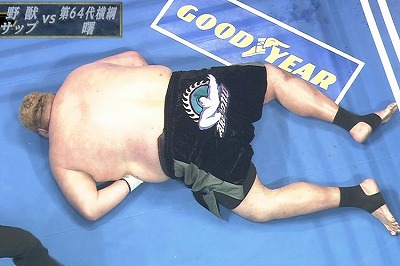
Akebono won 1 of his 12 fights in kickboxing and MMA and some people in Japan started to call him “Makebono” (make meaning “to lose” in Japanese) which probably had to sting just a little. Then in 2005 WWE came calling with the offer for him to wrestle the Big Show at Wrestlemania in a sumo match. The sight of Big Show and Akebono in Sumo gear might be the most memorable moment from the show for most WWE fans but it may have been the moment Akebono realized wrestling might be a better job then losing kickboxing fights. In August 2001 he made his debut with AJPW against The Great Muta. Afterwards, it was announced he would be training under Keiji Mutoh and had become a member of the roster. Mutoh and Akebono would team up in the company’s Real World Tag League (as it’s best known to US fans, RWTL for short) and make it all the way to the finals. At the end of 2005, Akebono won the “Rookie of the Year” and “Team of the Year” (with Mutoh) awards from Tokyo Sports. Mutoh then announced Akebono had finished his lessons and was ready to head out on his own.
At the January 2006 NJPW Tokyo Dome Akebono announced he had signed with the company. He’d take part in the 2006 and 2007 G1 Tag leagues and the 2007 G1 Climax but fail in his efforts to win. After leaving NJPW he joined HUSTLE, a now defunct company that focused more on sports entertainment (to say the least) than wrestling. I’d give you the entire storyline of MONSTER BONO’s creation and birth but I think you should locate it for yourselves. To give you a short version, Akebono debuted by hatching from a giant egg.
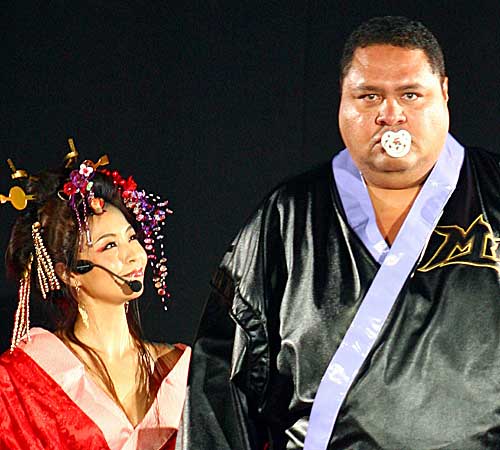
Under the control of his evil mother, Yingling, Monster Bono would carve a path of destruction through HUSTLE; fortunately he would turn on his mother when she refused to let him meet his father and he joined the forces of light. Akebono would rapidly progress through the stages of adolescence first as Bono-chan, then Bono-kun, and finally The Great Bono in his last battle before leaving the promotion. There’s a lot of depth in there. Or it was really silly.
After this Akebono made his way to Dragon Gate debuting in a September 2008 Battle Royal, which was more than a little unfair of him since virtually every other wrestler in the company was a junior heavyweight. Akebono would win his first wrestling championship by forming a team with DG’s Maasaki Mochizuki and Don Fujii and going after the company’s 6-man title, Open The Triangle Gate, which they won in October 2009 and held onto it for the second longest time in company history. Bono also began competing for the independent group ZERO1 in 2009, where he would team up with Shinjiro Otani, winning the Furinkazan tag tournament and holding the NWA International Tag Titles. Akebono would then win his first singles championship in March 2012 when he defeated KAMIKAZE to win the Z1 World Heavyweight Championship at the promotion’s 11th anniversary show. Akebono would vacate the title due to illness, which was reported as pneumonia, an illness he’s had recurring trouble with as he just missed a bunch of shows during the lead up to the Carnival.
Meanwhile, Akebono had returned to AJPW. He formed the team S.M.O.P. (Super Megaton Ohzumo Powers) with fellow super-duper heavyweight Ryoto Hama and won the All Asia Tag Championship in September 2009. S.M.O.P. would have only mixed success as a team, defending the title once and winning the title one more time but otherwise failing to live up to their seeming potential or otherwise doing comedy. In September 2013, Akebono began to show just what he could do on his own in AJPW though when he won a singles tournament by using his new finisher: a piledriver he dubbed “the Yokozuna Impact” to defeat among others Jun Akiyama and Go Shiozaki. In October 2013 Akebono defeated Suwama to win the Triple Crown Heavyweight Championship and since then has been regularly defending the title, already having made four successful defenses as of March 18th. For perspective Toshiaki Kawada has the current record for most Triple Crown defenses at 10 and it was done over roughly a year and a half. Some are fans of the more frequent title defenses, others aren’t. As far as Akebono’s chances to with the Carnival, I’d like to think he’s going to lose, although probably in the finals in order to setup a challenger. It doesn’t make much sense for him to win after how dominant he’s been.
Suwama
Kohei Suwama has been marked for success in AJPW from the moment he debuted and has been considered the “Ace” of the company for the last several years. Suwama was recruited by fellow former amateur wrestler Hiroshi Hase in 2004 to AJPW and after a brief time in the company dojo made his debut in October of that year. At the start of 2006 Suwama aligned himself with AJPW’s major heel faction Voodoo Murders and dropped his first name. In January of 2008 Suwama would turn on the Voodoo Murders by saving babyfaces Keiji Mutoh and Joe Doering. After defeating the leader of the Murders, TARU, 1 on 1 he entered himself in the Champion Carnival, which he won by defeating NJPW’s Hiroshi Tanahashi in the finals. On the 29th of April 2008 Suwama would win his first Triple Crown title by defeating Kensuke Sasaki and holding the title for five months. His breakout year wasn’t quite finished yet as he would attempt to win the Real World Tag League teaming with Satoshi Kojima but would fall just short and lose in the finals.
Suwama would regain the Triple Crown in August of 2010 by beating Minoru Suzuki and successfully defended the title for more than a year until being defeated by Jun Akiyama (who was then still part of NOAH) in August 2011. In late 2012 Suwama formed the Last Revolution team with Joe Doering which was expanded into a stable with the additions of Kaz Hayashi, Shuji Kondo, and Yasufumi Nakanoueno. In March 2013 Suwama defeated Masakatsu Funaki to win the Triple Crown for the third time in his career. When the split with Mutoh occurred, Suwama was one of the very first wrestlers to declare his loyalty to AJPW and certainly one of the most important. In the wake of the split Last Revolution was disbanded as a stable due to only Suwama and Doering remaining with the company. The two men would reform their tag team under the name Evolution however, and go after the Unified Tag Titles (AJPW likes combining belts) which they would win in October making Suwama the first man to hold 5 belts (counting the Triple Crown and the two unified tag titles separately) at one time in 12 years. This wouldn’t last long though as Suwama would lose the Triple Crown 5 days later to the current champion Akebono. Suwama would finish the year out strong though by winning the RWTL with Doering.
Suwama has the second longest combined-reign length with the Triple Crown in company history at 743 days, behind only Mitsuhara Misawa (at 1,799) and has completely dominated the company since 2008. Suwama is a safe and predictable choice to win the Carnival but it also doesn’t do much for the company and they desperately need to make or at least elevate some new stars and potential challengers for Akebono, especially at the pace they’re having him defend the Triple Crown.
Takao Omori
The veteran Omori may have worked for virtually every significant company in Japan (and many around the world) but he got his start in AJPW in 1992 being trained by the legendary Animal Hamaguchi. In 1995 Omori would win his first title by winning tag team gold in AJPW with Jun Akiyama and then in 1996 he would appear in the WWF’s Royal Rumble because hey, why not? It was in 1998 when Omori was partnered with Yoshihiro Takayama as NO FEAR that his career began to really take off, as the pairing clicked right from the start. NO FEAR would become the first ever team to simultaneously hold the AJPW All Asia Tag Titles and the Double Cup Tag Championship. When the split with AJPW and NOAH happened, both Omori and Takayama joined NOAH.
Omori’s career took a serious left turn in 2000 when at NOAH’s biggest event to date he, for reasons never explained, called his match with mega-superstar Shinya Hashimoto early, and placed himself squarely in the doghouse. After NO FEAR broke up Omori was sent to Harley Race’s WLW company in the US… or was he? While he was there, company boss and star Mitsuhara Misawa claimed that Omori hadn’t been sent to the US by NOAH and wouldn’t be welcome back in the company.
Omori returned to Japan in 2003 first for Riki Choshu’s short lived World Japan before signing with Zero1. During his time in Zero1 Omori would become one of the companies top stars and have a bloody feud with his former partner Takayama who had also left NOAH to become a freelancer. In August 2008 Omori announced he was leaving Zero1 and taking a break from wrestling. This only lasted until March 2009 when he appeared in NJPW to re-form his team with NJPW wrestler Manabu Nakanishi (they had teamed up in Zero1 and won tag gold in both companies). Omori would also participate in the 2009 G1 but fail to win. In 2010 Omori again announced his semi-retirement.
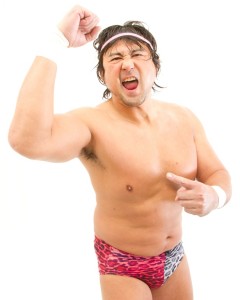
Just when it seemed like Omori’s once promising career had finally wound down he appeared again in AJPW asking Mutoh’s permission to rejoin the company which Mutoh granted. Omori was paired with young upcoming star Manabu Soya as the tag team GET WILD and given the instantly recognizable theme of the same name from the anime “City Hunter.” Coming to the ring clad in animal skins and furry boots (and being a good team in-ring) they were an instant hit and revived Omori’s career. In March 2012 GET WILD won the Unified Tag Titles for the first of three times. They would also win the 2012 RWTL Tournament and be named by Tokyo Sports as the 2012 Tag Team of the Year.
Sadly with the Mutoh/AJPW split the duo also went their separate ways. Soya, after playing coy for several months, recently debuted in WRESTLE-1 while Omori has stayed with AJPW. As far as the Carnival, Omori is unlikely to win as he’s already had a shot at Akebono and shouldn’t get another so soon.
Kento Miyahara
Miyahara was taken into the Kensuke Office dojo in 2007 and trained there by Kensuke Sasaki, Masa Saito, and his senior pupil Katsuhiko Nakajima. KOffice while also running their own shows mostly worked as a group of freelancers brought in by companies to liven things up and then move on after awhile, so it was with AJPW in 2008 that he made his debut before moving on to Pro Wrestling NOAH and teaming up with Naomichi Marufuji in an unsuccessful bid to win the NTV G+ Junior Tag Tournament. Miyahara spent the next few years with KOffice and would gain the reputation as its most promising graduate besides Nakajima, however, in August 2013 he announced he was leaving to join AJPW full-time.
Miyahara would join Go Shiozaki’s Xceed stable in February 2014 by saving them from a beating. He would get the biggest opportunity of his career in March when he received a Triple Crown title shot against Akebono but was defeated in under 10 minutes. Miyahara has become a quality wrestler and bulked up from his debut as a junior, but having just had a title shot and losing quickly, it doesn’t seem likely he’ll be winning the Carnival. Hopefully he’ll pick up a big win or two to regain some credibility though.
Osamu Nishimura
Nishimura is a graduate of the NJPW dojo and is about as old-school as they come these days. During his 23 year career he’s been trained by legends like Tatsumi Fujinami, Hiro Matsuda, Dory Funk Jr, and even Karl Gotch. He made his debut in 1991 and went on the traditional learning excursion to the US in 1994 where he took part in the notorious NWA World Heavyweight title tournament promoted by ECW. He returned to Japan briefly to take part in his mentor Fujinami’s unsuccessful MUGA splinter company before leaving again to spend time in Germany.
Nishimura made his return to NJPW in 1998 and was given a number of prominent matches with top stars during the angle with nWo-Japan. Unfortunately for Nishimura, he was diagnosed with cancer late in the year and was sidelined until 2000 when it finally went into remission. In order to return to true ring shape Nishimura traveled to the US to train under Dory Funk Jr in 2001 before returning to New Japan to team up with Fujinami to win the IWGP tag titles. After losing the titles, Nishimura would go through a few other partners including Hiroyoshi Tenzan with whom he would pick up another IWGP tag title reign and win the 2003 G1 Tag League but by 2006 he had fallen to the mid-card and decided to leave the company.
After making appearances for Chikara in the US and working for Fujinami’s revived MUGA World (currently known as Dradition, a portmanteau of “Dragon” and “tradition”) Nishimura along with trainee Manabu Soya left MUGA for AJPW in 2007. During 2008 Nishimura challenged Suwama for the Triple Crown, his first singles title opportunity in 5 years, but would ultimately be defeated. Nishimura would participate in several Carnivals and RWTLs but fail to advance far. His most significant contribution to the company may be his work as a trainer for the younger talent.
In recent years Nishimura has been working a reduced schedule since 2010 after deciding to go into politics but has since returned to wrestling. Nishimura is no longer a main event wrestler and although still a talented technical wrestler, I don’t see him coming anywhere near winning the Carnival.
Kendo Kashin
Kendo Kashin originally debuted in 1992 under his real name Tokimitsu Ishizawa for NJPW after a successful amateur career. Originally trained in the NJPW Dojo by Dean Malenko and Hiroshi Hase, he later also trained in the UWFI shoot style by Kazuo Yamazaki. In 1996 he defeated Yuji Nagata to win the Young Lion Cup and then left on a learning excursion to Austria where he first adopted his trademark masked look and name as Kendo Kashin.
He would return to New Japan under the hood and in 1999 win the Best of The Super Juniors tournament before going on to win the IWGP Junior Heavyweight title for the first time. Kashin would venture into the world of MMA in 2000 like so many other NJPW wrestlers in that time period and faced Ryan Gracie but he was defeated in under 2 minutes by TKO. Kashin would take several months off from NJPW to exclusively train for a rematch with Gracie in July of 2001; at PRIDE 15 he TKO’d him, marking his only win in MMA, and making him a bigger star in wrestling than ever before.
Kashin would return to NJPW that same month and win his second IWGP Junior title by beating Masayuki Naruse in only 26 seconds, which would make his next move all the more shocking; while still the champion Kashin defected to AJPW along with Keiji Mutoh and Satoshi Kojima. Once in AJPW, Kashin’s big push continued and he won the vacant AJPW Junior Heavyweight title as well as becoming the AJPW World Tag Team Champ by teaming with Yuji Nagata.
In 2004 Kashin would leave AJPW, once again while still holding a title, this time the tag titles. He actually kept the belt and AJPW sued him for it and Kashin would not return the belt to AJPW until May 2006 after his brief run with NJPW fell through. In 2005 Kashin wrestled for ROH as Dragon Soldier B in their Best of the American Super Juniors Tournament, even though he wasn’t American. He won the tournament despite having 3 bad matches and the crowd hating him. He has never wrestled for ROH since.
Kashin’s appearances in wrestling became more infrequent but after a hiatus he challenged Kurt Angle for his version of the IWGP title at one of Antonio Inoki’s IGF shows in December 2007, because IGF is random like that. Kashin would make some other appearances for IGF but was mostly inactive until making a shocking return to AJPW this year to announce he would be participating in the Champion Carnival. Does he have a chance at winning? I really hope not. But the fact they brought him in at all says a lot. I’ve never really been a fan of his so I’m a bit biased here.
Join me next time when I take a look at B Block from Jun Akiyama to Zeus (no not Hulk Hogan’s legendary rival)!



